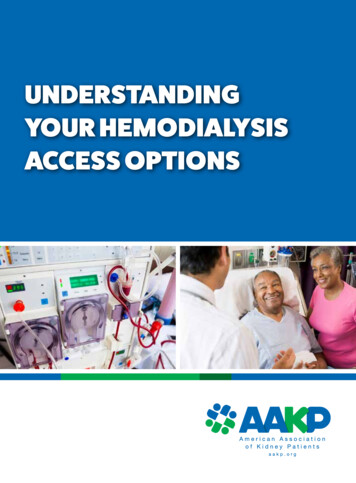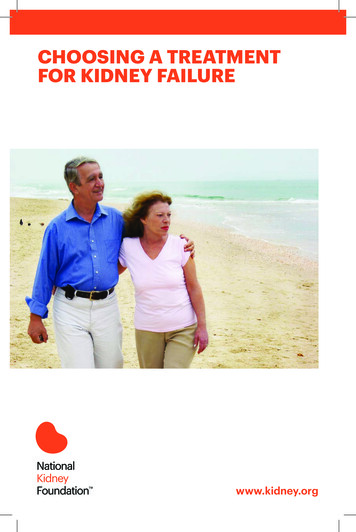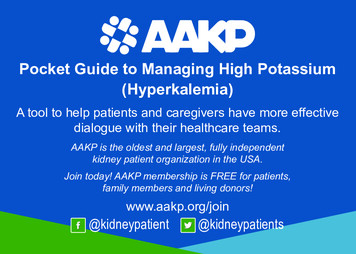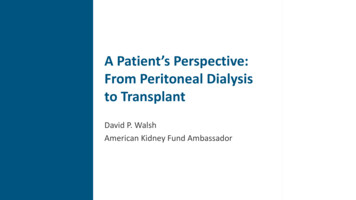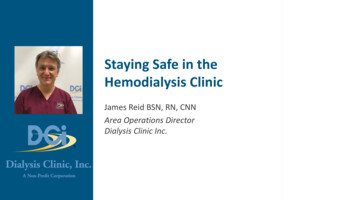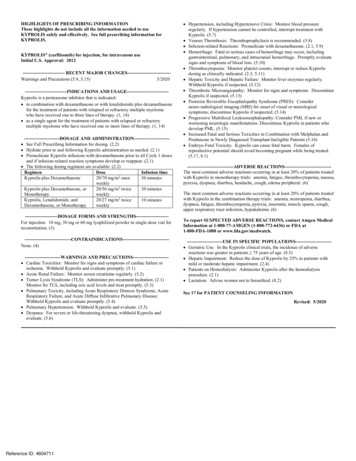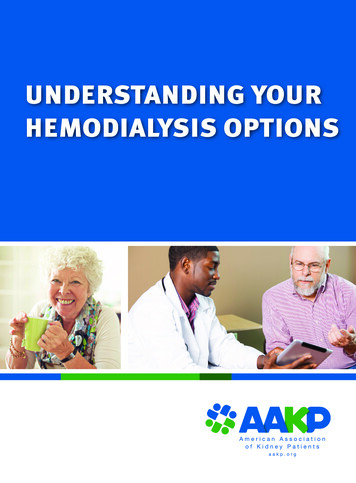
Transcription
UnderstandingUNDERSTANDINGYOURYourHEMODIALYSIS OPTIONSHemodialysisAccess Options
TABLE OF CONTENTSIntroduction.4What is kidney disease?.4What is hemodialysis?.5How do I prepare for hemodialysis?.5Where is hemodialysis done?.5How many times per week will I do hemodialysis?.7What are my choices for hemodialysis?.7In-Center Hemodialysis.8Home Hemodialysis.8Nocturnal Hemodialysis.12Can hemodialysis do everything my kidneys once did?.13Can I change treatments?.13Conclusion.13Definitions.15American Association of Kidney Patients: Understanding Your Hemodialysis Options3
INTRODUCTIONWHAT IS KIDNEY DISEASE?If you are reading this brochure,it means you need treatment forkidney failure now or in the nearfuture. Or you may have startedtreatment already, but want tolearn more about other treatmentoptions. There are two types oftreatments for kidney failure –dialysis and kidney transplant.Your kidneys keep you healthy.They clean your blood, help makered blood cells, help keep bloodpressure under control, keep theright balance of fluid in yourbody, and much more. If youhave kidney failure, it means:Dialysis comes in two forms—hemodialysis and peritonealdialysis. Both remove wasteproducts and extra fluid (water)from your blood. A kidneytransplant is an operation thatplaces a healthy kidney in yourbody.This brochure will help youunderstand hemodialysis.To learn more about kidneytransplantation, or peritonealdialysis, please read theAAKP Understanding KidneyTransplantation brochure andAAKP Understanding YourPeritoneal Dialysis Optionsbrochure. To download a FREEcopy or to order a copy online,visit www.aakp.org. You may alsocall 1-800-749-2257 to request acopy.4 Your kidneys have becomedamaged from an injuryor disease like diabetes orhigh blood pressure (or ahereditary condition, suchas Fabry Disease, AlportSyndrome, PolycysticKidney Disease) 85-90% of your kidneyfunction is gone forever Your kidneys do not workwell enough to keep yourbody functioning properlyHaving kidney failure does notmean you are going to die, butyou will need treatment withdialysis or a kidney transplantfor your lifetime. There is nocure for kidney failure. Withtreatment, you can live and doall the things you enjoy. You canwork, travel, go to school, raise afamily, be active, and enjoy yourlife.American Association of Kidney Patients: Understanding Your Hemodialysis Options
WHAT IS HEMODIALYSIS?Hemodialysis is one of thetreatments for kidney failure.A machine with a special filteris used to clean your blood andreplace some of the jobs yourkidneys would normally do.Here is how it works:At the start of every treatment,two needles are placed in yourarm. Depending on what typeof hemodialysis treatment youare doing (in-center or home),the individual inserting theneedles may be a nurse, dialysistechnician, care partner or you(the patient).Each needle is attached to a softtube connected to the dialysismachine. If needles bother you,a numbing cream or spray can beused. Some people prefer to puttheir own needles in (called selfcannulation).Your blood is pumped throughthe soft tubes into the dialysismachine. Don’t be afraid! Onlya small amount of blood is outof your body at any time, andyou cannot feel the blood beingpumped out. Once inside themachine, your blood goes througha special filter. The filter is calleda “dialyzer” or “artificial kidney.”The dialyzer allows waste andextra water to pass through, butkeeps the important things yourbody needs, like nutrients. Thewastes and extra water go into acleansing fluid inside the dialysismachine (called “dialysate”), andyour cleaned blood flows backto you. This process can takeseveral hours.HOW DO I PREPARE FORHEMODIALYSIS?Before you can beginhemodialysis, you will need apermanent access (an entrance)to your blood vessels. This iswhere the two needles will beinserted each time you havetreatment. An access is createdduring a minor operation. Thereare three types of access – afistula, a graft, or a catheter.Fistula. A fistula is therecommended choice for anaccess. It has fewer problems andlasts longer. It is made by joiningan artery to a nearby vein underthe skin in your arm. (An arteryis a blood vessel that carriesblood away from your heart. Avein is a blood vessel that carriesblood to your heart.) When anartery and vein are joined, thevein grows wider and thicker,making it easier to place theAmerican Association of Kidney Patients: Understanding Your Hemodialysis Options5
GRAFTAV FISTULAneedles for dialysis. It may soundscary, but it is a simple procedure.A fistula should be made severalmonths before starting dialysis togive it enough time to fully healand be ready for use.Graft. If your blood vessels havecertain problems, a fistula maynot work for you. In that case,a graft may be used. A graftis made by joining an arteryand nearby vein with a small,soft, man-made tube. The graft(including the tube) is completelyunder your skin.Catheter. A catheter is a thin,flexible tube that is insertedthrough your skin into a largevein in the neck, chest, or groin.It is a safe procedure. The endsof the tube stick out throughyour skin all day and every day.6CATHETERDoctors use catheters on peoplewho only need dialysis for ashort time (temporarily due toa possible acute kidney injury– which is a sudden episode ofkidney failure or kidney damagethat happens within a few hoursor a few days). It can also be usedfor people on long-term dialysis,but only if a fistula or graftcannot be placed – since cathetershaving a higher rate of infection.If you would like moreinformation about thedifferent kinds of access forhemodialysis, please read theAAKP Understanding YourHemodialysis Access Optionsbrochure. To download a FREEcopy or to order a copy online,visit www.aakp.org. You may alsocall 1-800-749-2257 to request acopy.American Association of Kidney Patients: Understanding Your Hemodialysis Options
WHERE IS HEMODIALYSISDONE?You can do hemodialysis at homeor in a dialysis center. Yourhealthcare team can help youdecide which option is best foryou. In making a choice, youwill need to consider manythings, including your lifestyle,your health, and your wishes.You will also need to considerwhether you want to do yourtreatments during the daytimeor nighttime—and how manytreatments per week.Choosing where, when, and howoften you will do your treatmentsis important. Start by askingyourself these questions: Wouldyou be more comfortable doinghemodialysis at home or in acenter? At night while you sleepor during the daytime? Moretreatments per week for shortertimes or fewer treatments per weekfor longer times? Learning abouteach treatment choice will helpyou and your healthcare teamselect one that works best for you.HOW MANY TIMESPER WEEK WILL I DOHEMODIALYSIS?This will depend on which type ofschedule you choose. There arethree choices: Conventional HemodialysisShort Daily Hemodialysis(also called “ShortFrequent”)Nocturnal Hemodialysis All three can be done at homeor in a dialysis center. Each isexplained in the following pages.QUICK SUMMARYHemodialysis can be done: At homeIn a dialysis centerThere are three types ofschedules to choose from. Allthree can be done at home orin a dialysis center: ConventionalShort DailyNocturnalAmerican Association of Kidney Patients: Understanding Your Hemodialysis Options7
WHAT ARE MY CHOICESFOR HEMODIALYSIS?Your treatment days and timeswill be scheduled by the center.In-Center HemodialysisA dialysis center is located in aclinic or hospital. Trained staffdoes all aspects of your treatment.They place the access needles andtubing; monitor the machines;watch your vital signs duringtreatment; clean the equipmentafter each use; and order supplies.You may be able to do some thingsyourself, like insert the needlesinto your access (called selfcannulation).Conventional In-CenterHemodialysis. Treatments areusually three times a week. Eachtreatment is usually betweenthree to five hours. Treatmentsare done during the daytime ina dialysis center. The days andtimes are scheduled by the center.An example of a conventionalin-center hemodialysis scheduleis: Monday, Wednesday, andFriday from 9:00 am to 1:00 pm.Most dialysis centers offer two orthree shifts for treatment times.The time you spend during eachdialysis treatment will dependon your body size, lab results,and general health. Your kidneydoctor (called a “nephrologist”)will prescribe the length of yourtreatment.It’s helpful to tour a dialysiscenter to see how it looks andsounds before choosing thistype of treatment. Most dialysiscenters are designed as an openarea with reclining chairs alongthe wall and a dialysis machinebeside each chair. There areusually televisions at each chair.While you’re having treatment,you can read, sleep, watch TV, orwork on your computer.8Short Daily In-CenterHemodialysis. Treatments areusually five to seven times a week.Each treatment is less than threehours. A recent study suggeststhat having dialysis more thanthree times a week may give youa better quality-of-life and health.The majority of people who wantshort daily hemodialysis willneed to do dialysis at home. (Youwill learn more about homehemodialysis in the next section.)HOME HEMODIALYSISYou can also do dialysis in thecomfort of your own home. Thisoption may require help froma care partner. If the homehemodialysis machine you areAmerican Association of Kidney Patients: Understanding Your Hemodialysis Options
Your Hemodialysis Choices*This chart may help you compare where, when, and how often you willdo dialysis depending on your treatment choice. Not all choices areavailable in all areas.In CenterHemodialysisConventionalHow Often: Usually 3 times a weekEach Treatment: 3-5 hoursTime of Day: DaytimeWhere: Dialysis center(clinic or hospital)HomeHemodialysisConventionalHow Often: Usually 3 times a weekEach Treatment: 3-5 hoursTime of Day: DaytimeWhere: HomeShort DailyShort DailyHow Often: 5-7 times a weekHow Often: 5-6 times a weekEach Treatment: Less than 3 hoursEach Treatment: 2-3 hoursTime of Day: DaytimeTime of Day: DaytimeWhere: Dialysis CenterWhere: HomeNocturnalNocturnalHow Often: Usually 3 times a weekHow Often: 5-7 times a weekEach Treatment: Over 5 hoursEach Treatment: Over 5 hoursTime of day: NighttimeTime of day: NighttimeWhere: Dialysis centerWhere: Home*Adapted from KDOQI HD Adequacy Guidelines; 2015 Update.Am J Kidney Dis. 2015; 66(5) 884-930.American Association of Kidney Patients: Understanding Your Hemodialysis Options9
using requires a partner, yourcare partner will need to be withyou and assist you each timeyou do a dialysis treatment. Itis important for you to choose adependable person with whomyou work well.Some people hire a nurse ortechnician to be their care partner(not covered by Medicare), butmost care partners are a familymember, spouse/partner, or closefriend.You and your care partner willget special training from a nurseon how to do your treatmentssafely. Training generally laststhree to eight weeks and is donein a dialysis clinic that offershome treatment options. Onceyou and your healthcare team areconfident in your ability to dotreatment at home, you can beginhome hemodialysis. Your centerwill arrange for you to get theequipment and regular delivery ofsupplies.With home dialysis, you are incharge of your treatment. Youwill set up your machine, prepareit for treatment, and clean itafterwards. After treatment, youwill dispose of used supplies.You will also need to set up yourhome for the machine and other10equipment. This could includesome changes to your home’splumbing and electricity. Theremust be suitable electrical outletsand plumbing to make the dialysissolution and to drain the machine.Medicare may help with the costof some these changes. Be sureto discuss with your healthcareteam.A nurse will be available bytelephone at all times who cananswer questions, assist you indealing with problems, arrangefor technical support of themachine, and give you advice.And you will be followed closelyby your healthcare team. Theywill see you every month forblood tests and checkups. Youwill still have access to the sameprofessional team as someone whodoes treatments in a center. Yourhealthcare team can also arrangefor you to dialyze in a center whenyou or your care partner travelor take vacations. They can alsoguide you on how best to travelwith your home hemodialysismachine.Many people feel that doingdialysis at home allows them agreater sense of control, moreindependence, the flexibility tochoose a time of day for dialysis,and overall better health. Plus,American Association of Kidney Patients: Understanding Your Hemodialysis Options
there is no need to travel to adialysis center, except for monthlycheckups.For more information on homedialysis options, please read theAAKP Understanding Your HomeHemodialysis Options brochureor the AAKP UnderstandingYour Peritoneal Dialysis Optionsbrochure. To download a FREEcopy or to order a copy online,visit www.aakp.org. You may alsocall 1-800-749-2257 to request acopy.matches normal kidney functionmore closely than havingtreatment only three times a weekat an in-center facility. Less fluidand waste gathers in the bodybetween treatments. You may alsofind that you have more flexibilitywith your kidney-friendly diet!Conventional HomeHemodialysis. Treatments areusually three times a week. Eachtreatment lasts between three tofive hours. Treatments are doneduring the daytime at home withthe help of a care partner.A NEW HOMEHEMODIALYSIS MACHINEShort Daily Home Hemodialysis.With short daily homehemodialysis, you will have moretreatments per week for shorterperiods. Treatments are usuallyfive to six times a week, andeach treatment lasts about twoto three hours. Treatments aredone during the daytime at homewith a care partner. Many peoplefeel their quality of life improveswith this schedule–- they sleepbetter and feel more comfortable.In fact, short daily hemodialysisA new hemodialysis machinefor home use is now availablethat may not require a carepartner—but only if you doyour treatments during thedaytime and your healthcareteam agrees you are able todo treatments alone. Peopledoing home hemodialysistreatments at night will stillneed a care partner or mustbe monitored by a dialysisnurse over the phone orinternet.American Association of Kidney Patients: Understanding Your Hemodialysis Options11
NOCTURNALHEMODIALYSISNocturnal (nighttime) dialysisinvolves longer, slower treatmentswhile you sleep. It can be donein a dialysis center or at home.Nocturnal dialysis is twiceas long and twice as often asconventional hemodialysis. Itdoes a better job of cleaning theblood of wastes, salt, and water.It is the closest method to normalkidney function. You may havemore energy, less nausea, morestamina, and a better appetite.There are fewer complaints ofitchy, dry skin or “restless legsyndrome.” Since dialysis takesplace at night during sleepinghours, you have more time forwork or school, family, friends,and other activities. Not allcenters offer this type of dialysis.Your healthcare team can tell youif this option is available in yourarea.In-center nocturnalhemodialysis. In-centernocturnal hemodialysis meansyou sleep at the dialysis centerovernight. The center will bein “sleep mode” with the lightsoff. You will sleep in a bed.The dialysis staff will start andend your treatment and watchyou while you sleep. They will12connect your access to the dialysismachine with a secure line thatsounds an alarm if it senses anywetness around your access, andthey will look after the machine.It can take time to get used tosleeping in a center. You mayhear the staff walking around orthe noises made by the dialysismachine. Some people may findthat difficult. It is usually donethree times a week. Treatmentslast five hours or more.Home nocturnal hemodialysis.With this option, you will do yourtreatments at home while yousleep. It is usually done five toseven times a week. The length ofeach treatment can be as long asyou want to sleep, with six to eighthours being the average. At somelocations, a trained nurse overseesyour treatment from outside yourhome by using an internet ortelephone connection. The nursewill monitor your machine, andevaluate pressures, flows, fluidremoval, and alarms. If you haveany problems, the machine will“alert.” If you do not respondwithin a reasonable time, thestaff will contact you by phone. Ifremote monitoring isn’t availableat your center, you may need acare partner instead. This may bea spouse or family member wholives with you. You and your careAmerican Association of Kidney Patients: Understanding Your Hemodialysis Options
partner will be trained on howto do your treatments at home,care for your machine, insertthe needles, order supplies, andmuch more. You will also have a24-hour telephone number to callif you have questions, problems,or need advice. Your healthcareteam will see you every monthfor blood tests and checkups. Youwill have the same professionalhealthcare team looking afteryour health as those who dohemodialysis in a center.CAN HEMODIALYSIS DOEVERYTHING MY KIDNEYSONCE DID?Dialysis will save your life, but itcannot do everything that healthykidneys can do. In addition todialysis, you will need to follow atreatment plan. For most people,this means taking medication(s),following a kidney-friendly dietas directed by your doctor and/or dietitian, and limiting howmuch water and other liquid youdrink or take in through foods.Your healthcare team will createa treatment plan just for you.A dietitian trained in kidneydisease can help you create mealsthat give you the right amount ofnutrients.CAN I CHANGETREATMENTS?Yes. If you start on one type oftreatment, you may be able tochange to a different treatmentlater on – if that’s what you want.In fact, many people with kidneyfailure have had more than onetype of treatment during theyears. For example, you canchoose hemodialysis now, but stillchange to peritoneal dialysis ata later date. Even if you want akidney transplant, you may needto do dialysis while you waitfor an available kidney. If youare interested in changing yourtreatment at any time, talk toyour healthcare team. You shouldchoose a treatment option thatmatches your lifestyle, your goalsand your wishes.CONCLUSIONWhen choosing a treatmentfor kidney failure, you shouldconsider your health, yourfamily, your lifestyle, and yourpersonal preference. Learn allyou can about each treatmentoption and discuss it with yourfamily and healthcare team.Making an informed choice willhelp you choose the treatmentthat’s best for you. The moreyou learn, the easier it will beAmerican Association of Kidney Patients: Understanding Your Hemodialysis Options13
to make a choice. Here are somekey points to remember: There are two types oftreatments for kidneyfailure – dialysis and kidneytransplant. Dialysis comes in twoforms—hemodialysis andperitoneal dialysis. Bothremove waste productsand extra fluid from yourblood. A kidney transplantis an operation that places ahealthy kidney in your body. Hemodialysis can be done athome or in a dialysis center.It can also be done at nightwhile you sleep (at home or ina center).14 If you start on one type oftreatment, you may still beable to change treatmenttypes at a later date.Not all types of hemodialysistreatments are available inall areas.In addition to dialysis,you will need to follow atreatment plan for your besthealth (take medication(s),follow a kidney-friendly diet,and limit fluids.)To learn more about treatmentsfor kidney failure, talk to yourhealthcare team. You can also callthe AAKP at 1-800-749-257 or visitthe website at www.aakp.org.American Association of Kidney Patients: Understanding Your Hemodialysis Options
DEFINITIONSAccess: The site where needles areconnected to your body so that bloodcan flow into the dialysis machine.Dialysis center: A place in a hospitalor clinic where dialysis treatmentsare given to kidney patients.Alport Syndrome: A geneticcondition characterized by kidneydisease, hearing loss, and eyeabnormalities. People with Alportsyndrome experience progressive lossof kidney function.Dietitian: A member of yourhealthcare team who will help youplan what to eat and drink to help youfeel your best.Artery: A blood vessel that carriesblood away from your heart.Care Partner: A person who helpsyou do hemodialysis at home.Catheter: A soft, flexible tube that isput into your body for dialysis.Conventional Hemodialysis: Atreatment that is usually done threetimes a week. It can be done at homeor in a dialysis center.Diabetes: A condition that happenswhen your body cannot makeenough insulin or cannot use insulinproperly. Insulin is a hormone thatcontrols how much sugar is in yourblood. Diabetes is a leading cause ofkidney failure.Dialysis: A process that filters wasteproducts and extra fluid from yourblood when your kidneys cannot dothis well enough to keep you alive. Itis one of the basic forms of treatmentfor kidney failure.Dialyzer: A part of the hemodialysismachine that removes wastes andextra fluid from your blood.Fabry Disease: A rare geneticdisorder caused by a defective gene(the GLA gene) in the body.Fistula: A permanent entrancefor hemodialysis. It is created byconnecting a vein and artery in yourarm during minor surgery.Graft: A man-made blood vessel thatis inserted under your skin during aminor operation. It creates an access(entrance) for dialysis.Healthcare Team: A team of peoplewho help with your medical care.Your team may include a nephrologist,advanced practitioner, nurse, dialysistechnician, dietitian, social worker,transplant coordinator and transplantsurgeon. You are also a member ofyour team!Hereditary: A condition that ispassed down from a parents’ genes.Hemodialysis: One of the basicforms of dialysis treatment. Inhemodialysis, your blood is cleanedof wastes and extra fluid through amachine.High Blood pressure: A conditionin which the force of blood pushingagainst the inner walls of your bloodvessels is too high. It is a leadingcause of kidney failure.American Association of Kidney Patients: Understanding Your Hemodialysis Options15
DEFINITIONSKidneys: Two organs located oneither side of the spine. Kidneysremove waste products from thebody, balance the body’s fluids, andrelease hormones that control bloodpressure, make red blood cells, andkeep bones healthy.Kidney disease: The loss of some orall of your kidney function. Kidneydisease can result from conditionssuch as high blood pressure, diabetes,or an injury to the kidneys.Kidney failure: The stage of kidneydisease at which dialysis or atransplant is needed to stay alive.Kidney transplant: An operationthat places a healthy kidney in yourbody. It is one of the basic forms oftreatment for kidney failure.Peritoneal dialysis: One of thebasic forms of dialysis treatment. Asolution flows into your abdominalcavity (belly), where it removes wasteand extra fluid, and then is drainedout.Polycystic Kidney Disease: A geneticdisorder that causes many fluid-filledcysts to grow in your kidneys. Thesecysts may enlarge the size of yourkidneys and cause kidney failure.Short Daily Hemodialysis: Atreatment for kidney failure thatinvolves short treatments five toseven days per week. It can be doneat home or in a dialysis center.Vein: A blood vessel that carriesblood to your heart.Nephrologist: A doctor who isspecially trained in treating kidneydisease and kidney failure.Nocturnal Hemodialysis: Atreatment for kidney failure that isdone while you sleep. It involveslong, slow treatments at home or in adialysis center.Nutrients: Chemicals that you getfrom food that are needed live andgrow.16American Association of Kidney Patients: Understanding Your Hemodialysis Options
IN-CENTER Staff performsall aspects oftreatment Friendshipsmight developwith thosedialyzing duringyour same shiftHEMODIALYSIS OPTIONS:ADVANTAGESHOMENOCTURNAL SHORT-DAILY Dialysis isdone in thecomfort ofyour home Flexibility tochoose a timeof day fordialysis Moreflexibilityfor activities,includingwork, school,family, andfriends No need totravel toa dialysiscenter Allowsfor moreindependenceand control Allows for amore flexiblediet Many peoplefeel theiroverall health(physical,social,mental)improveswith homedialysis17 Long, slow Less fluid You may have Most peopletreatments doa better job ofcleaning yourbloodmore energy,less nausea,better health Closestmethodto normalkidneyfunction More timefor daytimeactivities,includingwork, school,family, andfriendsand wastegathers in thebody betweentreatmentshave betterhealth andquality-of-lifecompared todialysis threetimes weekly Less timeneeded torecover afterdialysis3 Allows for amore flexiblediet No need totravel toa dialysiscenter Allows for amore flexibledietAmerican Association of Kidney Patients: Understanding Your Hemodialysis Options
HEMODIALYSIS OPTIONS:DISADVANTAGESIN-CENTER You may havelittle control and/or involvementin yourtreatment asstaff performsall aspects oftreatment You must travelto a center atleast three timesweekly Treatment daysand times arescheduled bythe center andmay not beaccommodating May not fit yourschedule orlifestyle There may berules againsteating ordrinking in thefacilityHOME A carepartner maybe neededdependingon the homehemodialysismachinebeing used(No carepartner isneeded forperitonealdialysis another typeof hometreatment)NOCTURNAL SHORT-DAILY Not availablein all areas For homenocturnal,you need acare partner,training, andspace in yourhome forequipmentand supplies Higher risk ofyour accessneedingrepairs Some peoplefind it hardto sleep whiledoing dialysis Training isrequired Space isneededto storeequipmentand suppliesAmerican Association of Kidney Patients: Understanding Your Hemodialysis Options18
Become a Member ofUnlock all of the AAKP resources today! Just register online to get instant anInstitutionalLife Member 0 45/year 100/year 200/year 1) AnnualSubscriptionaakpRENALIFEMagazine(5) AnnualSubscriptionsaakpRENALIFEMagazine(10) AnnualSubscriptions toaakpRENALIFEMagazineLifetime Subscription toaakpRENALIFE MagazineAAKPE-Newsletters(emailsubscription)AAKP E-Newsletters(email AKP E-Newsletters(email subscription)Life Member Pin &CertificateAAKPEducationalBrochures*AAKP EducationalBrochures*AAKP EducationalBrochures*(1) Set of Printed AAKPEducational Brochures(upon account set-up)AAKP E-Newsletters(email ebinarsAAKPHealthLinewebinars5% Discount on BulkOrders of AAKPEducational Brochures(1) Set of printed AAKPEducational Brochures(upon account set-up)Discount onDiscount on NationalNational Meeting Meeting registrationregistrationwith CEUsDiscount onNational MeetingregistrationAAKPHealthLine webinarsAAKPHealthLine webinarsCenter for PatientEngagement &Advocacy AlertsCenter for PatientEngagement &Advocacy AlertsCenter for PatientEngagement &Advocacy AlertsDiscount on NationalMeeting registrationfor up to (5) employeeswith CEUsDiscount on NationalMeeting registration forup to (2) individuals withCEUs for healthcareprofessionalsAccess to marketresearch andclinical trialsAccess to marketresearch andclinical trialsAccess to marketresearch andclinical trialsCenter for PatientEngagement &Advocacy AlertsCenter for PatientEngagement & AdvocacyAlertsInformation onlocal supportgroupsInformation on localsupport groupsInformation onlocal supportgroupsAccess to marketresearch andclinical trialsAccess to marketresearch andclinical trialsSpeakingopportunities atAAKP programs/eventsSpeakingopportunities atAAKP programs/eventsInformation on localsupport groupsInformation on localsupport groupsSubmit articles foraakpRENALIFEmagazineSubmit articles foraakpRENALIFEmagazineSpeaking opportunitiesat AAKP programs/eventsSpeaking opportunities atAAKP programs/eventsSubmit articles foraakpRENALIFEmagazineSubmit articles foraakpRENALIFEmagazine*A small fee is required for print subscription of aakpRENALIFE and educational brochures.To become a member go online to http://www.AAKP.org/Join or call 1-800-749-2257.American Association of Kidney Patients: Understanding Your Hemodialysis Options19
14440 Bruce B. Downs Blvd. Tampa, FL 33613aakp.org 800-749-AAKP info@aakp.orgVisit our Web site at twitter.com/KidneyPatients05082019
4 American Association of Kidney Patients: Understanding Your Hemodialysis Options INTRODUCTION If you are reading this brochure, it means you need treatment for kidney failure now or in the near future. Or you may have started treatment already, but want to learn more about other treatment options. There are two types of
